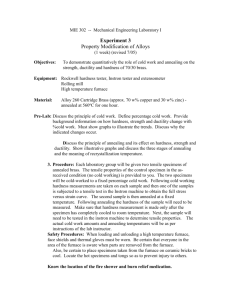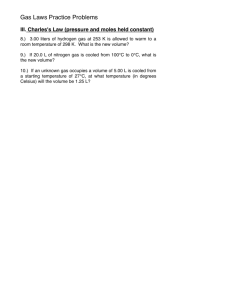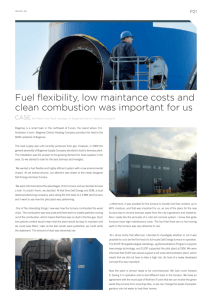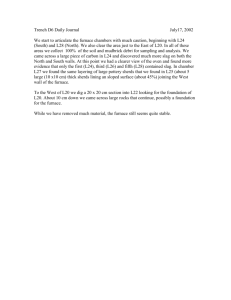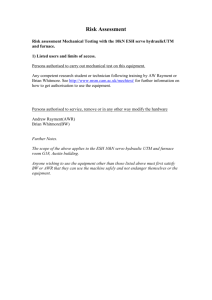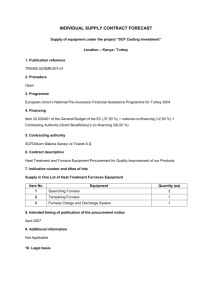Full Density Properties of Low Alloy Steels
advertisement
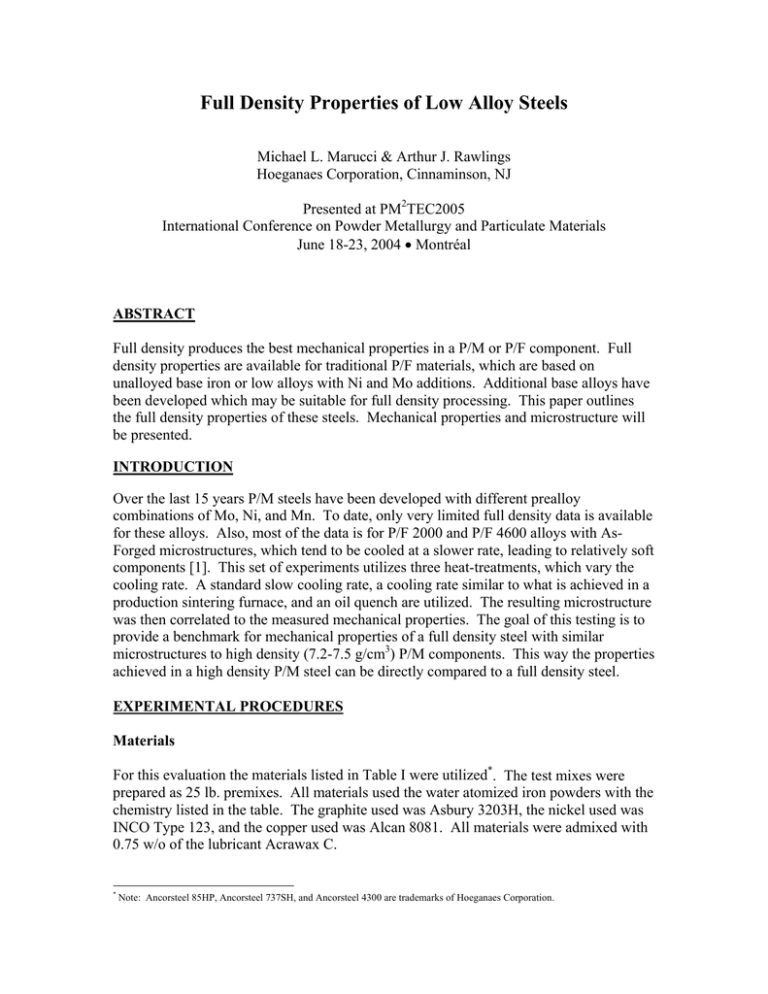
Full Density Properties of Low Alloy Steels Michael L. Marucci & Arthur J. Rawlings Hoeganaes Corporation, Cinnaminson, NJ Presented at PM2TEC2005 International Conference on Powder Metallurgy and Particulate Materials June 18-23, 2004 • Montréal ABSTRACT Full density produces the best mechanical properties in a P/M or P/F component. Full density properties are available for traditional P/F materials, which are based on unalloyed base iron or low alloys with Ni and Mo additions. Additional base alloys have been developed which may be suitable for full density processing. This paper outlines the full density properties of these steels. Mechanical properties and microstructure will be presented. INTRODUCTION Over the last 15 years P/M steels have been developed with different prealloy combinations of Mo, Ni, and Mn. To date, only very limited full density data is available for these alloys. Also, most of the data is for P/F 2000 and P/F 4600 alloys with AsForged microstructures, which tend to be cooled at a slower rate, leading to relatively soft components [1]. This set of experiments utilizes three heat-treatments, which vary the cooling rate. A standard slow cooling rate, a cooling rate similar to what is achieved in a production sintering furnace, and an oil quench are utilized. The resulting microstructure was then correlated to the measured mechanical properties. The goal of this testing is to provide a benchmark for mechanical properties of a full density steel with similar microstructures to high density (7.2-7.5 g/cm3) P/M components. This way the properties achieved in a high density P/M steel can be directly compared to a full density steel. EXPERIMENTAL PROCEDURES Materials For this evaluation the materials listed in Table I were utilized*. The test mixes were prepared as 25 lb. premixes. All materials used the water atomized iron powders with the chemistry listed in the table. The graphite used was Asbury 3203H, the nickel used was INCO Type 123, and the copper used was Alcan 8081. All materials were admixed with 0.75 w/o of the lubricant Acrawax C. * Note: Ancorsteel 85HP, Ancorsteel 737SH, and Ancorsteel 4300 are trademarks of Hoeganaes Corporation. Table I: Test Material Matrix Designation Base Iron FL-4405* Ancorsteel 85HP FLN2-4405* Ancorsteel 85HP Alloyed Elements Fe-0.85Mo Fe-0.85Mo Admixed Elements 0.6C 2.0Ni + 0.6C *MPIF Standard 35 Designation Note: All carbon added as graphite Sample Preparation All samples were prepared from slugs with a 4.0 in diameter. The slugs were first prepared as pressed performs. Performs were pressed to a medium density (6.8-6.9 g/cm3) and subsequently sintered at 2050°F in dissociated ammonia. Following sintering, the sintered performs were reheated to 1700°F and hot forged at 60 tsi. The process allowed for lateral flow of the material and the final part had a geometry of 5.0 in diameter with an overall length of 2.0 in. The approximately 7 lb. slugs were then allowed to air cool. From the full density slugs, machined round tensile samples were produced according to MPIF standard 10. In addition, V notch Charpy impact specimen were prepared according to ASTM standard E23. Heat Treatment Three heat-treatments/cooling conditions were used for the full density testing. The conditions are outlined as follows: As-Forged 7 lb. Samples slow cooled from forging temperature. No further heat-treatment. Sinter Furnace Cool Test samples machined from As Forged condition into final geometries (section thickness less than 0.5 in). The samples were then subsequently passed through a belt sintering furnace with accelerated cooling. The samples achieved a temperature of 2050°F and were cooled with the accelerated cooling. Subsequent to this process the samples were tempered at 400°F. Quenched & Tempered Test samples machined from As Forged condition into final geometries (section thickness less than 0.5 in). The samples were then subsequently austenitized at 1650°F and quenched in warm agitated oil (180°F). Subsequent to this process the samples were tempered at 400°F. Testing Tensile testing was performed on a Tinius-Olsen universal testing machine with a crosshead speed of 0.01 in/min. An external ‘clip on’ extensometer was used to measure elongation and was left on until sample failure. The V notch Charpy impact samples were tested on a Baldwin impact tester. Apparent hardness was measured using a Mitutoyo Rockwell hardness tester; the Rockwell C scale was used for all samples. RESULTS AND DISCUSSION Mechanical Properties The apparent hardness values for the steels tested are shown in figure 1. The data show that FL-4405 material is not affected by the faster sinter furnace cooling, however, Q&T conditions increases hardness substantially to about 55 HRC. This is due to the limited hardenability of the material. The FLN2-4405 material does benefit from the accelerated cooling rate. The addition of Ni gives a 10-point increase in hardness. However, at this cross section thickness, the Ni offers little benefit when the parts are quenched and tempered. 60 55 FL-4405 Apparent Hardness (HRC)> 50 FLN2-4405 45 40 35 30 25 20 15 10 5 0 As-Forged Figure 1: Sinter Furnace Cool Q&T Apparent hardness as a function of heat-treatment. The ultimate tensile strength also follows the same trend as the hardness (figure 2). The Ni gives a boost in strength in the sinter furnace cooled condition but at the highest cooling rate the strength is the same. This difference will widen as the cross section size increases. The absolute tensile strength in the quenched and tempered condition is quite high. The yield strength follows a similar trend. There is some scatter in the FL-4405 and FLN2-4405 Q&T data caused by defects in the tensile samples, which lead to some premature failures. The measured strength is lower than what the actual value should be. The maximum elongation for all conditions is quite good compared to the same composition in a medium density P/M condition. Elongation values of 6-12% were observed. The FLN2-4405 with sinter furnace cooling had the poorest elongation; this may be due to its mixed microstructure of martensite and bainitic areas. 350 325 FLN2-4405 275 3 Ultimate Tensile Strength (10 psi) 300 FL-4405 250 225 200 175 150 125 100 75 50 As-Forged Figure 2: Sinter Furnace Cool Q&T Ultimate tensile strength as a function of heat-treatment. 250 FL-4405 230 FLN2-4405 3 Yield Strength (10 psi) > 210 190 170 150 130 110 90 70 50 As-Forged Figure 3: Sinter Furnace Cool Q&T Yield Strength as a function of heat-treatment. 15.0 14.0 FL-4405 13.0 FLN2-4405 Maximum Elongation (%)> 12.0 11.0 10.0 9.0 8.0 7.0 6.0 5.0 4.0 3.0 2.0 1.0 0.0 As-Forged Figure 4: Sinter Furnace Cool Elongation as a function of heat-treatment. Q&T The impact energy for all conditions scaled with cooling rate. The Ni only had a small effect on the measured values. However as strength and hardness increased so did impact toughness. The values for the V notch samples are still quite low even with the full density processing, as the medium carbon content still lends itself to a steel with very high strength and only modest toughness. 14 13 12 FL-4405 FLN2-4405 11 Impact Energy (ft.lbf)> 10 9 8 7 6 5 4 3 2 1 0 As-Forged Figure 5: Sinter Furnace Cool Q&T Impact Energy (V-Notch Charpy) as a function of heat-treatment. Comparison with P/M Materials Comparing the full density data with P/M shows the strong linear relation ship between mechanical properties and density continues up to full density. Examination of figure 6 shows that the yield and tensile strengths increase with density when processed under similar cooling conditions. The properties are independent of processing route. Figure 7 shows a similar trend for the elongation, however, the increase in elongation from a density of 7.55 g/cm3 to full density departs from linearity and increases substantially. 200 Yield Strength 175 Ultimate Tensile Strength 125 3 Strength (10 psi) 150 100 75 50 25 0 7.10 Standard Compaction Figure 6: 7.35 Warm Compaction 7.55 Warm Compaction + DPDS Full Density P/F Comparison of tensile and yield strength of FLN2-4405 over a range of densities. All samples processed in the sinter furnace cooled condition. 10 9 Maximum Elongation (%) 8 7 33 HRC 6 5 4 3 2 95 HRB 99 HRB 7.35 Warm Compaction 7.55 Warm Compaction + DPDS 84 HRB 1 0 7.10 Standard Compaction Figure 7: Full Density P/F Comparison of maximum elongation and apparent hardness of FLN2-4405 over a range of densities. All samples processed in the sinter furnace cooled condition. Microstructure Optical photomicrographs of FL-4405 in all three cooling conditions are shown in Figure 8. The optical photomicrograph of FL-4405 in the as forged condition consists primarily of coarse pearlite. The carbides are not a perfect lamella structure, but rather, are more random. This feature is consistent with other P/M steels alloyed with Mo. The sinter furnace cooled sample consists of a similar structure, however the structure is more lamellar and has a finer carbide spacing. There are also regions of unresolved carbide present (bainite). The quenched and tempered sample consists of 100% martensite. This hard phase explains the excellent hardness and strength exhibited via this heat-treatment. Fracture surfaces from the V notch Charpy samples for FL-4405 material are shown in Figure 9. The surface of the as forged and sinter furnace cooled samples consist primarily of cleavage, consistent with brittle fracture. There are some ductile areas consistent with the pot marked areas among the cleavage. There are areas of transgranular fracture and intergranular fracture present in both samples. This suggests that the ductile to brittle transition temperature for these materials is lower than room temperature. The Q&T sample primarily consists of ductile fracture. The entire surface consists of pot marks. One interesting note is that the scale of the fracture surface in the Q&T sample is much finer compared to the slower cooling rates and the fracture appears to be completely transgranular. Figure 8 a: Etched microstructure of FL-4405 As-Forged (Original magnification = 500X, Etch: 2%Nital/4%Picral) Figure 8 b: Etched microstructure of FL-4405 Sinter Furnace Cool (Original magnification = 500X, Etch: 2%Nital/4%Picral) Figure 8 c: Etched microstructure of FL-4405 Q&T (Original magnification = 500X, Etch: 2%Nital/4%Picral) Figure 9 a: SEM Fractograph of FL-4405 As-Forged (Charpy V-Notch Specimen) Figure 9 b: SEM Fractograph of FL-4405 Sinter Furnace Cool (Charpy V-Notch Specimen) Figure 9 c: SEM Fractograph of FL-4405 Q&T (Charpy V-Notch Specimen) CONCLUSIONS • • • • • The hardness of the materials tested are dependent on alloying and achieved microstructure. FL-4405 achieves about 25 HRC in the as forged and sinter furnace cooled condition. Heat-treatment increases hardness substantially to about 55 HRC. The ultimate tensile strength for FL-4405 approaches 125,000 psi in the as forged and in the sinter furnace cooled condition. Heat-treatment raises tensile strength in excess of 300,000 psi. Yield strength in the as forged and sinter furnace cooled condition is about 80,000 psi and is increased substantially to 240,000 psi in the heat-treated condition. Elongation for all forged steels fall in the rage of 6-12%. Ni has only a small effect on elongation in the as forged and Q&T conditions. In the sinter furnace cooled condition the FLN2-4405 had lower elongation due to its heterogeneous microstructure. The impact toughness is dependent on cooling rate. As cooling rate increases impact toughness increases. The hardened Q&T condition produces the highest impact energy. The presence of admixed Ni only has a modest effect on toughness, most notable in the sinter furnace cooled condition. For FL-4405, the microstructure produced in the as forged condition consists of coarse divorced pearlite. The sintered furnace cooled condition produces a finer divorced pearlite microstructure with some bainitic areas. The Q&T sample consists of 100% martensite. Fracture surfaces of FL-4405 in the as forged and sinter furnace cooled condition primary exhibit brittle fracture. The facets are quite coarse and the fracture propagated between the grains (intergranular). The hardened Q&T sample exhibited a much finer ductile fracture surface with fine pot marks where the crack propagated through the grain structure (transgranular) REFERENCES 1. 2. 3. James, W.B., McDermott, M.J., and Powell, R.A., “Powder Forging”, Forming and Forging, Volume 14, 9th edition of Metals Handbook, ASM International, 1988, p. 188. Donaldson, I.W., Luk, S., Poszmik, G., Narasimhan, K. S., “Processing of Hybrid Alloys to High Densities”, Advances in Powder Metallurgy & Particulate Materials, 2002, MPIF, Princeton, NJ. Donalson, I.W., Marucci, M.L., “Effect of Double Press, Double Sinter and Heat Treatment on the Properties of High Density FLN2-4405”, Advances in Powder Metallurgy and Particulate Materials, 2003, MPIF, Princeton, NJ. APPENDIX: Table II: Mechanical Property Summary Modulus As-Forged FL-4405 FLN2-4405 Sinter Furnace Cool FL-4405 FLN2-4405 Q&T FL-4405 FLN2-4405 Yield Strength Tensile Strength Elongation Charpy Impact Hardness (106 psi) (GPa) (103 psi) (MPa) (103 psi) (MPa) (103 psi) (ft.lbf) (J) (HRC) 23.8 26.2 164 180 79 83 543 569 122 115 843 791 11.2 10.5 4 3 5 4 21 23 30.7 28.1 212 194 82 112 566 776 121 172 837 1187 12.6 6.0 5 7 7 10 21 33 28.3 29.2 195 201 240 215 1652 1485 313 313 2155 2159 9.0 10.0 9 10 12 13 55 56
